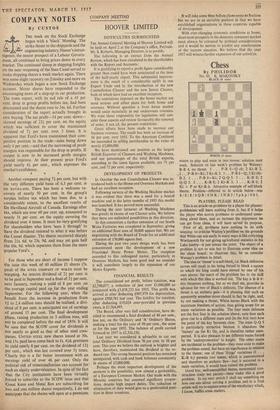Chess
By PHILIDOR No. 93. K. MAKOVSKY BLACK (4 men) WHITE (6 men) WHITE to play and mate in two moves: solution next week. Solution to last week's problem by Watney: B-B 4, no threat. 1 . . . P-R 8=Q ch; 2 Kt-R 2.
1 P-R 8--Kt; 2 Kt-K 3. 1 P-B 8=Q; 2 Kt (4)- B 2. 1 . . . P-B 8—Kt; 2 Q-Q 5. 1 . . . K-R 8; 2
Q-Q 5. 1 . . . K-B 8; 2 Kt-K 3. 1 • K-B 6; 2 Kt x P or Kt-B 6. Attractive example of self-block theme. Position—referred to in article below—was 8/8 /8 / 6QB/ 6 NK/ 3 NB3 / 5 pkp/ 6 b I.
PLAYERS, PLEASE READ
This is an article on problems by a player for players: problemists will learn nothing from it, but if it helps the player who scorns problems to understand some- thing about them, and so increase the enjoyment he can get from chess, it will have served its purpose.
First of all, problems have nothing to do with winning: to criticise Watney's problem on the grounds that White can win easily in many ways is like criticising Wordsworth for not giving agricultural statistics in his Lake poetry—it just misses the point. The object of a problem is not to win but to illustrate some idea on the chess board: w illustrate this, let us consider Watney's problem in detail.
The idea or 'theme' is a self-block, i.e. Black defensive moves will result in his being forced to block a square to which his king could have moved by one of his own pieces: the merit of the problem lies in the skill with which this idea is worked out. The key is B-B 4: this threatens nothing, but as we shall see, provides in advance for two of Black's defences. The absence of a threat is an msthetic gain—it is pleasing that such an apparently senseless move should in fact be right, and, by not making a threat, White leaves Black with the maximum freedom of action, thus giving scope for as many variations as possible. The four main defences are the first four in the solution above; note how each gives rise to a different mate and (in the first two) how the point of the key becomes clear. The mate Q-Q 5 is particularly attractive because it abandons the 'battery' on the Kt file, and is therefore rather unex- pected. It is also pleasant to see different mates forced by the 'underpromotion' to knight. The other mates are incidental to the problem—they must exist to make the problem sound, but have no significance in relation to the theme; one of these 'fringe' variations (1 . K-B 6;) permits two mates, which is uneconomical and therefore an testhetic flaw—had it occurred in a main variation, it would have ruined the problem. Good key, well-exemplified theme, economical con- struction (only ten pieces)—these make this a. good problem. In my next article I shall say something on how one sets about solving a problem and in a final article will try to explain some of the vocabulary which, 1 know, baffles some readers.


































 Previous page
Previous page